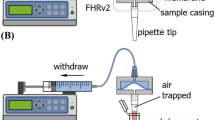Abstract
By utilizing the high gas permeability of polydimethylsiloxane (PDMS), a simple syringe-assisted pumping method was introduced. A dead-end microfluidic channel was partially surrounded by an embedded microchamber, with a thin PDMS wall isolating the dead-end channel and the embedded microchamber. A syringe was connected with the microchamber port by a short tube, and the syringe plunger was manually pulled out to generate low pressure inside the microchamber. When sample liquid was loaded in the inlet port, air trapped in the dead-end channel would diffuse into the surrounding microchamber through the PDMS wall, creating an instantaneous pumping of the liquid inside the dead-end channel. By only pulling the syringe manually, a constant low flow with a rate ranging from 0.089 to 4 nl/s was realized as functions of two key parameters: the PDMS wall thickness and the overlap area between the dead-end channel and the surrounded microchamber. This method enabled point-of-care pumping without pre-evacuating the PDMS devices in a bulky vacuum chamber.



Similar content being viewed by others
References
Dimov IK, Basabe-Desmonts L, Garcia-Cordero JL, Ross BM, Ricco AJ, Lee LP (2011) Stand-alone self-powered integrated microfluidic blood analysis system (SIMBAS). Lab Chip 11(5):845–850
Gervais L, Delamarche E (2009) Toward one-step point-of-care immunodiagnostics using capillary-driven microfluidics and PDMS substrates. Lab Chip 9(23):3330–3337
Hosokawa K, Sato K, Ichikawa N, Maeda M (2004) Power-free poly(dimethylsiloxane) microfluidic devices for gold nanoparticle-based DNA analysis. Lab Chip 4(3):181–185
Hosokawa K, Omata M, Sato K, Maeda M (2006) Power-free sequential injection for microchip immunoassay toward point-of-care testing. Lab Chip 6(2):236–241
Li W, Chen T, Chen Z, Fei P, Yu Z, Pang Y, Huang Y (2012) Squeeze-chip: a finger-controlled microfluidic flow network device and its application to biochemical assays. Lab Chip 12(9):1587–1590
Liang DY, Tentori AM, Dimov IK, Lee LP (2011) Systematic characterization of degas-driven flow for poly(dimethylsiloxane) microfluidic devices. Biomicrofluidics 5(2):024108–024116
Mark AE, Bruce KG (2006) A PDMS-based gas permeation pump for on-chip fluid handling in microfluidic devices. J Micromech Microeng 16(11):2396
Merkel TC, Bondar VI, Nagai K, Freeman BD, Pinnau I (2000) Gas sorption, diffusion, and permeation in poly(dimethylsiloxane). J Polym Sci, Part B: Polym Phys 38(3):415–434
Nilghaz A, Wicaksono DHB, Gustiono D, Abdul Majid FA, Supriyanto E, Abdul Kadir MR (2012) Flexible microfluidic cloth-based analytical devices using a low-cost wax patterning technique. Lab Chip 12(1):209–218
Ong W-L, Tang K-C, Agarwal A, Nagarajan R, Luo L-W, Yobas L (2007) Microfluidic integration of substantially round glass capillaries for lateral patch clamping on chip. Lab Chip 7(10):1357–1366
Sung JH, Kam C, Shuler ML (2010) A microfluidic device for a pharmacokinetic-pharmacodynamic (PK-PD) model on a chip. Lab Chip 10(4):446–455
Tang X, Zheng B (2011) A PDMS viscometer for assaying endoglucanase activity. Analyst 136(6):1222–1226
Trung NB, Saito M, Takabayashi H, Viet PH, Tamiya E, Takamura Y (2010) Multi-chamber PCR chip with simple liquid introduction utilizing the gas permeability of polydimethylsiloxane. Sens Actuators B Chem 149(1):284–290
Weibel DB, Siegel AC, Lee A, George AH, Whitesides GM (2007) Pumping fluids in microfluidic systems using the elastic deformation of poly(dimethylsiloxane). Lab Chip 7(12):1832–1836
Xia YN, Whitesides GM (1998) Soft lithography. Annu Rev Mater Sci 28:153–184
Yetisen AK, Akram MS, Lowe CR (2013) Paper-based microfluidic point-of-care diagnostic devices. Lab Chip 13(12):2210–2251
Ziegler J, Zimmermann M, Hunziker P, Delamarche E (2008) High-performance immunoassays based on through-stencil patterned antibodies and capillary systems. Anal Chem 80(5):1763–1769
Acknowledgments
This work was partially supported by grants from NSF (ECCS-1002255 and ECCS-0736501).
Author information
Authors and Affiliations
Corresponding author
Electronic supplementary material
Below is the link to the electronic supplementary material.
Supplementary material 2 (WMV 1822 kb)
Supplementary material 3 (WMV 8073 kb)
Supplementary material 4 (WMV 3862 kb)
Supplementary material 5 (WMV 2197 kb)
Rights and permissions
About this article
Cite this article
Xu, L., Lee, H. & Oh, K.W. Syringe-assisted point-of-care micropumping utilizing the gas permeability of polydimethylsiloxane. Microfluid Nanofluid 17, 745–750 (2014). https://doi.org/10.1007/s10404-014-1356-4
Received:
Accepted:
Published:
Issue Date:
DOI: https://doi.org/10.1007/s10404-014-1356-4




